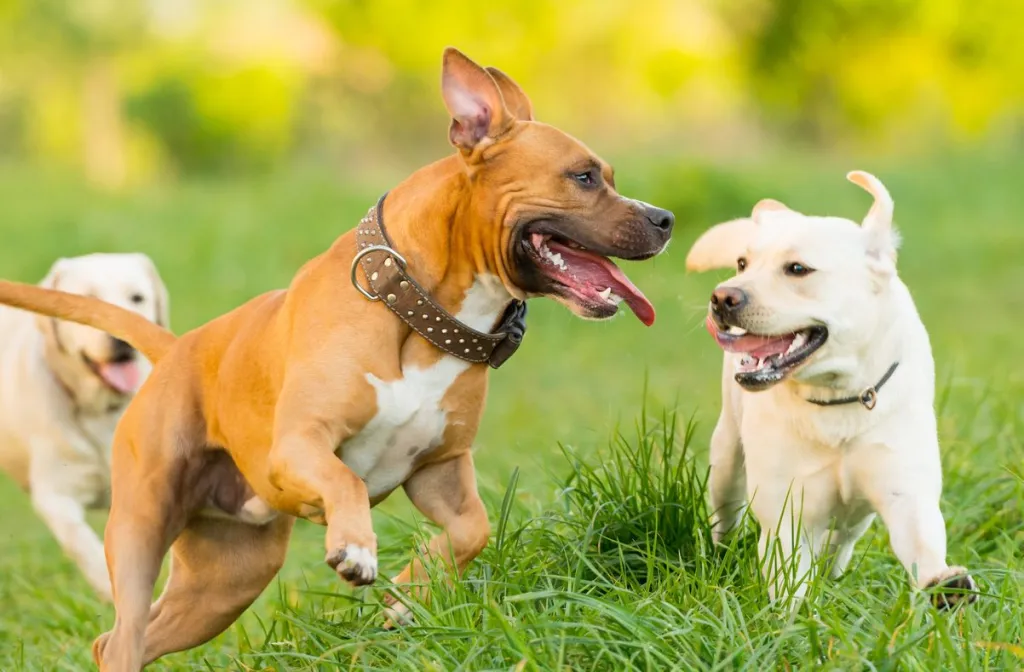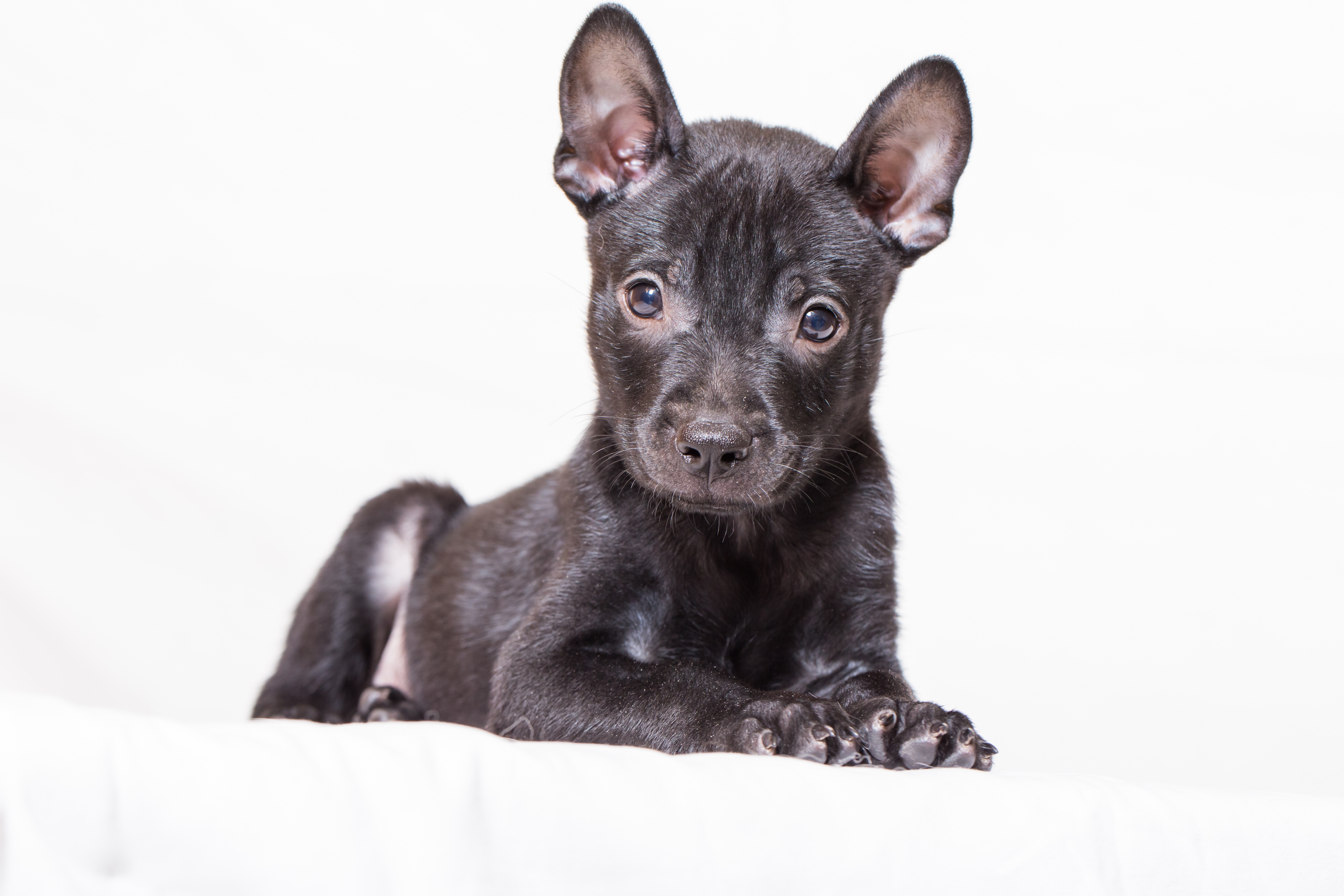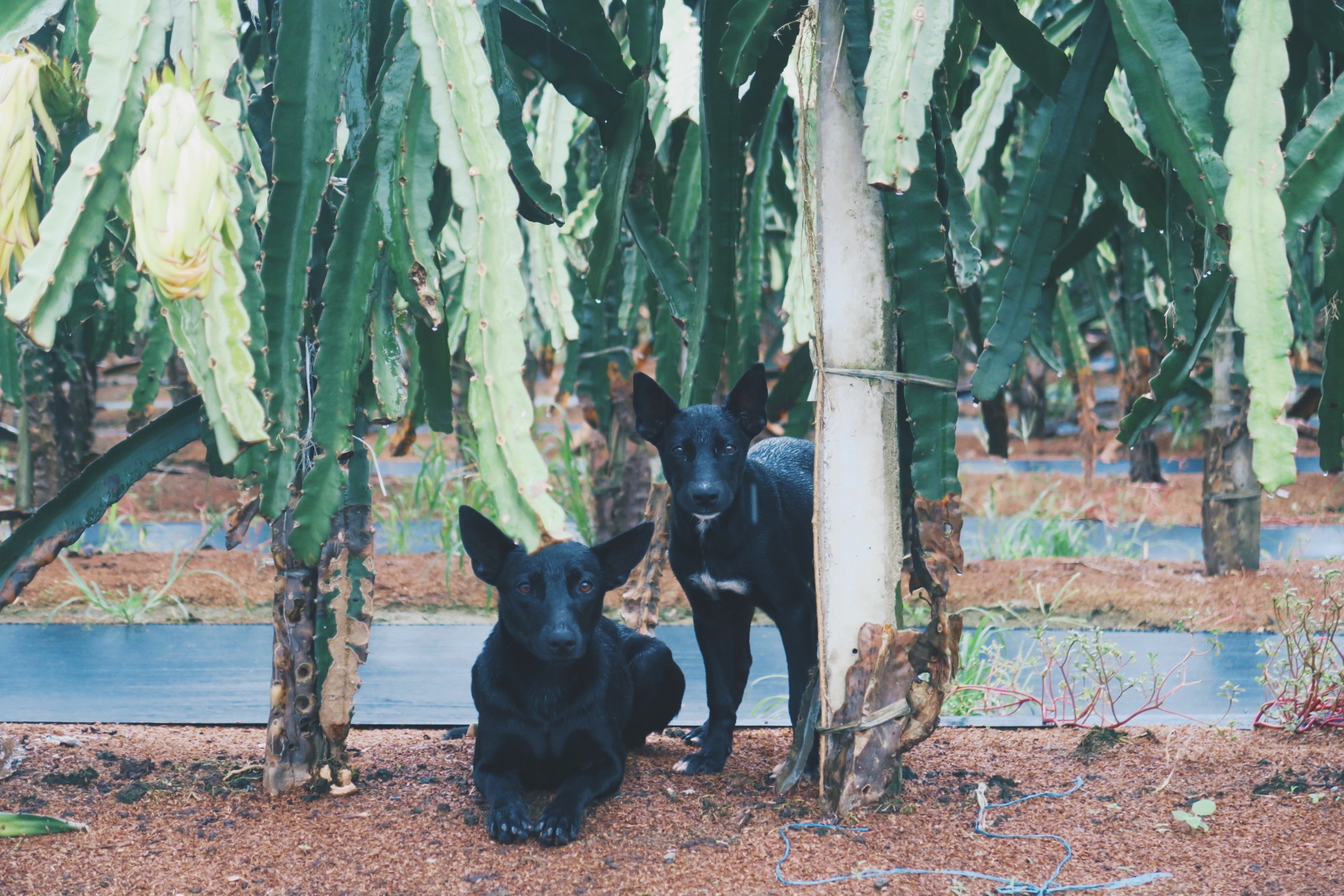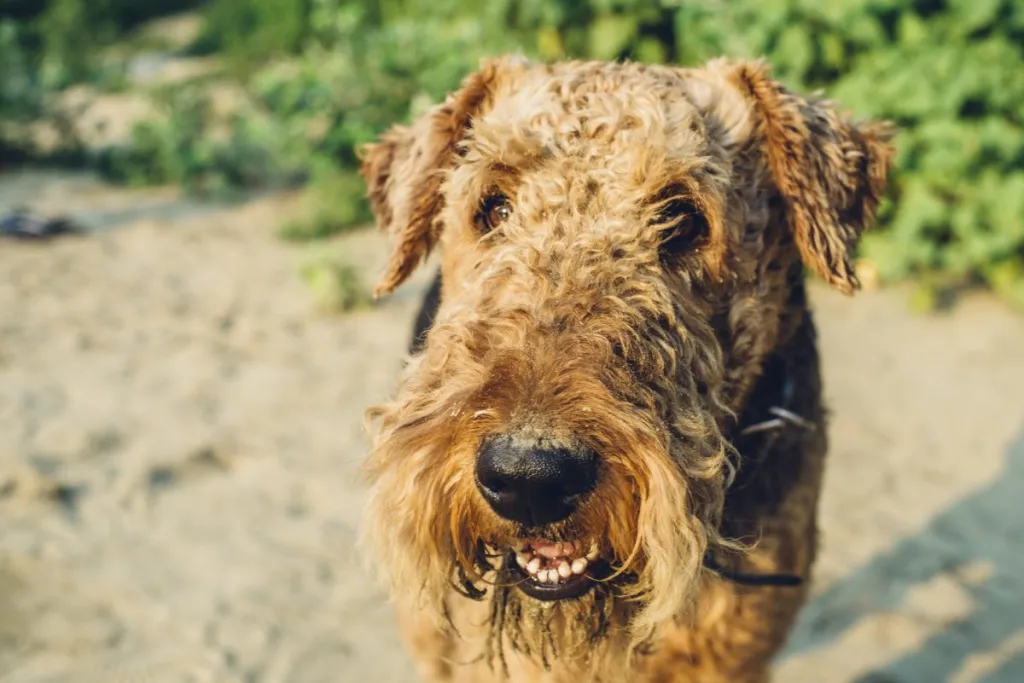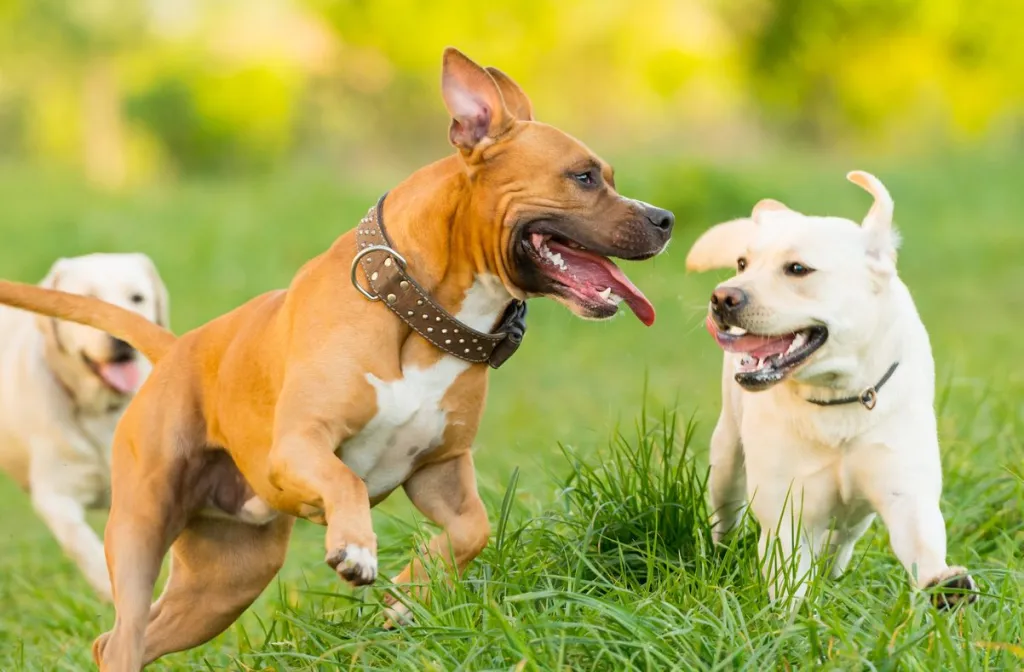
Taiwan Dog
An ancient dog breed, the Taiwan Dog has been a loyal companion to humans for centuries. Although these versatile dogs are mostly found in their native country today, enthusiasm for the rare breed is rising.
This increasingly popular canine goes by several other names, including Taiwanese Native Dog, Takasago Dog, and Formosan Mountain Dog. Although these are rare, purebred dogs, you may still find them in shelters and rescues. Remember to adopt! Don’t shop if this is the breed for you.
Reading: Taiwan Dog
Taiwan Dogs can thrive in nearly any environment, as long as their humans are firm and consistent with training. The intelligent breed can be stubborn and may pick up unwanted guarding habits, so they may not be the best choice for a novice pet parent. Still, if you’re looking for a loyal and affectionate companion who’s ready to go wherever you are, this might be the breed for you!
See below for complete list of dog breed traits and facts about Taiwan Dogs!
Taiwan Dog Breed Pictures
Adaptability
-
Adapts Well To Apartment Living
Looking for the best dog for your apartment? Contrary to popular belief, the suitability of dogs who adapt well to apartment living goes beyond its size. Apartment dwellers have a myriad of dog breeds to choose from as potential companions, with various factors to consider. Some large breeds can adapt well to apartment living and have lower activity levels. Others may require more space and possess higher energy levels. On the other hand, certain small dog breeds with abundant energy can still find contentment with indoor playtime or brisk walks.
However, when selecting a dog that adapts well apartments, it is essential to prioritize your neighbors. Opting for a pet that doesn’t excessively bark and behaves politely when encountering others in shared spaces like is crucial for maintaining a harmonious apartment environment.
In high-rise settings, it’s worth noting that numerous small dogs may exhibit a propensity for high energy and frequent barking. This makes them less suitable for apartment living. Therefore, desirable qualities in an apartment dog encompass being quiet, low-energy, and displaying polite behavior towards other residents.
Factors To Consider When Choosing A Dog For An Apartment
When considering dogs that adapt well to apartments, size alone should not be the sole determinant. Apartment dwellers have a wealth of dog breeds to choose from as potential furry companions. It’s important to remember that the size of your living space is just one factor to consider. While some larger breeds can adapt well to apartment living, with lower, others may require more space and have higher energy levels, making them less suitable for smaller apartments. Conversely, certain small dog breeds with higher energy levels can still thrive in apartments, finding contentment through indoor playtime or brisk walks. However, it is crucial to consider your neighbors’ comfort when selecting a dog. Opt for a pet that doesn’t bark excessively and behaves politely when interacting with others in shared spaces.
Therefore, it’s important to prioritize qualities such as being quiet, low-energy, calm indoors, and exhibiting good manners when living in close proximity to other residents. By considering these factors, you can find a dog that will adapt well to apartment living and create a harmonious living environment for everyone involved.
- Dogs Not Well Suited to Apartment Living
Click here for more information on this characteristic
-
Good For Novice Owners
Some dogs are simply easier than others; they take to training better and are fairly easygoing. They’re also resilient enough to bounce back from your mistakes or inconsistencies.
Dogs who are highly sensitive, independent thinking, or assertive may be harder for a first-time dog parent to manage. You’ll get your best match if you take your dog-owning experience into account as you choose your new pooch.
If you’re new to dog parenting, take a look at 101 Dog Tricks and read up on how to train your dog!
- See Dogs Who Are Good For Experienced Owners
Click here for more information on this characteristic
-
Sensitivity Level
Some dogs will let a stern reprimand roll off their backs, while others take even a dirty look to heart. Low-sensitivity dogs, also called “easygoing,” “tolerant,” “resilient,” and even “thick-skinned,” can better handle a noisy, chaotic household, a louder or more assertive owner, and an inconsistent or variable routine. Do you have young kids, throw lots of dinner parties, play in a garage band, or lead a hectic life? Go with a low-sensitivity dog.
- See Dogs Who Have Low Sensitivity Levels
Click here for more information on this characteristic
-
Tolerates Being Alone
Some breeds bond very closely with their family and are more prone to worry or even panic when left alone by their owner. An anxious dog can be very destructive–barking, whining, chewing, and otherwise causing mayhem. These breeds do best when a family member is home during the day or if you can take the dog to work.
- See Dogs Poorly Suited To Be Alone
Click here for more information on this characteristic
-
Tolerates Cold Weather
Breeds with very short coats and little or no undercoat or body fat, such as Greyhounds, are vulnerable to the cold. Dogs with a low cold tolerance need to live inside in cool climates and should have a jacket or sweater for chilly walks. You can find a great jacket for your dog here!
- Click here to see Dogs Poorly Suited For Cold Weather
Click here for more information on this characteristic
-
Tolerates Hot Weather
Dogs with thick, double coats are more vulnerable to overheating. So are breeds with short noses, like Bulldogs or Pugs, since they can’t pant as well to cool themselves off. If you want a heat-sensitive breed, your dog will need to stay indoors with you on warm or humid days, and you’ll need to be extra cautious about exercising your dog in the heat.
- See Dogs Poorly Suited For Hot Weather
Click here for more information on this characteristic
All-around friendliness
-
Affectionate With Family
When it comes to unconditional love and unwavering loyalty, few animals can rival the affectionate nature of dogs. These remarkable creatures have earned their reputation as man’s best friend, and it’s no wonder! Many breeds are particularly renowned for their love and devotion to their families. With their warm hearts and wagging tails, affectionate family dogs enrich the lives of their owners in countless ways.
While we like to think that all dogs are creatures of love, some breeds may be more outwardly affectionate than others. Some of this is due to temperament, breed group, and purpose. For example, dogs first bred for working or guarding independently of their human companions may show less affection than dogs specifically bred to be companion animals. Of course, this is no indication of the bond between a human and pup, but rather related to temperament and breed origin.
Affection may be demonstrated through a myriad of heartwarming behaviors. This may including tail-wagging greetings, cuddles on the couch, and an ever-present eagerness to be by their family’s side. This devotion extends to both adults and children, making dogs wonderful additions to family households. The warmth of a dog’s affection not only provides emotional support but also creates an environment of joy and connection within the family, fostering a sense of togetherness.
How To Know If A Dog Is Good With Families
The affectionate nature of family dogs extends beyond play and cuddles. Dogs have a remarkable ability to sense their owner’s emotions, offering comfort and support during difficult times. Whether it’s a wagging tail after a long day at work or a sympathetic nuzzle during moments of sadness, they prove time and again that they are attuned to their family’s needs.
It is important to note that not all dogs of the same breed will be equally affectionate. Some dogs may be more independent or aloof, while others may be more clingy or demanding of attention. The best way to find out how affectionate a dog is is to meet them in person and interact with them.
See Dogs Less Affectionate with Family
Click here for more information on this characteristic
-
Kid-Friendly
Being gentle with children, sturdy enough to handle the heavy-handed pets and hugs they can dish out, and having a blasé attitude toward running, screaming children are all traits that make a kid-friendly dog. You may be surprised by who’s on that list: Fierce-looking Boxers are considered good with children, as are American Staffordshire Terriers (which are considered Pit Bulls). Small, delicate, and potentially snappy dogs such as Chihuahuas aren’t always so family-friendly.
- See Dogs Who Are Not Kid Friendly
**All dogs are individuals. Our ratings are generalizations, and they’re not a guarantee of how any breed or individual dog will behave. Dogs from any breed can be good with children based on their past experiences, training on how to get along with kids, and personality. No matter what the breed or breed type, all dogs have strong jaws, sharp pointy teeth, and may bite in stressful circumstances. Young children and dogs of any breed should always be supervised by an adult and never left alone together, period.
Click here for more information on this characteristic
-
Dog Friendly
Friendliness toward dogs and friendliness toward humans are two completely different things. Some dogs may intimidate other dogs, even if they’re love-bugs with people; others are naturally more dog friend and would rather play than fight. It’s important to note that breed isn’t the only factor when it comes to how dog-friendly your pup will be. Sure, some dogs breeds first bred for working independently may not immediately gravitate towards other dogs, but early socialization plays a lot more into how dogs will interact than their origin. Dogs who lived with their littermates and mother until at least six to eight weeks of age or who spent lots of time playing with other dogs during puppyhood are more likely to have good canine social skills.
Still, some dog-friendly breeds are more pack-oriented and naturally thrive with other dogs. Dogs with this trait typically exhibit an innate ability to get along well with other pups. Dogs with this trait may be more eager to greet new dogs, display more social behavior at places like dog parks, or more confidently allow intimate sniffs from their canine acquaintances. This quality extends beyond mere tolerance and often manifests as a genuine enjoyment of the company of fellow canines, making these dogs ideal companions for those looking to build a multi-dog household. Additionally, they’ll pair well with pet parents hoping to take their pooch on social adventures, such as going to dog park or hanging out on dog-friendly patios.
Raising a dog-friendly dog
(Photo Credit: Stefan Cristian Cioata | Getty Images) While some dog breeds are more naturally inclined to make friends with other dogs, you may choose a puppy or adult dog that needs a little help. It’s may be common knowledge that there is a small window during a puppy’s early development when they are the most adaptable in terms of how they’ll interact with other dogs. You may, however, bring home an adult dog or a rescue and not get the opportunity. Not to fear! There are still many ways to help your pooch become dog-friendly.
Socialization is always the best way to ensure your dog becomes their most friendly self. You can help by exposing your pooch to as many sights, sounds, and environments as possible. Set up doggy playdates, enroll in dog training classes, or visit the dog park. Of course, be sure to do your research on dog training methods to ensure your dog will listen to you in social settings. Confidence is key!
- See Dogs Who Are Not So Dog Friendly
Click here for more information on this characteristic
-
Friendly Toward Strangers
Stranger-friendly dogs will greet guests with wagging tails and nuzzles; others are shy, indifferent, or even aggressive. However, no matter what the breed, a dog who was socialized and exposed to lots of different types, ages, sizes, and shapes of people as a puppy will respond better to strangers as an adult. Remember that even friendly dogs should stay on a good, strong leash like this one in public!
- See Dogs Who Are Less Friendly To Strangers
Click here for more information on this characteristic
Health And Grooming Needs
-
Amount Of Shedding
When considering adding a pup into your home, you may want to consider the amount of shedding your furry companion will experience. Regardless of the dog breed, you will want to be prepared for at least some amount of pet hair on your clothing and around your house. Of course, this amount can vary greatly as shedding tendencies differ significantly among breeds. Some dogs shed continuously, especially dog breeds with heavy double-coats or long fur. Others undergo seasonal “blowouts” and some hardly shed at all.
Read more : Rottweiler
Having a set of grooming tools at your disposal is essential for tending to your dog’s coat. Deshedding tools are excellent for eliminating excess hair that can become trapped in your dog’s fur. There are also brushes designed to gently remove dead hair without causing discomfort to your dog’s skin. Grooming gloves and bathing brushes can aid in loosening dead hair during shampooing, making it easier to brush away. Clippers and a detangling spray effectively tackle matted fur. Additionally, home tools for managing pet hair on fabric and furniture can make a big difference. Pet tape rollers, fur brooms, and specialized vacuums can eliminate pet hair from carpet, clothing, and even furniture.
If you’re someone who values a spotless environment, you might want to opt for a low-shedding breed. Otherwise, equip yourself with the right tools to fight the fur. Concerns about shedding shouldn’t prevent you from relishing your time at home with your dog. Establishing a consistent grooming regimen can significantly minimize the presence of loose hair in your living space and on your clothing. For additional guidance on managing dog shedding, explore our recommendations for addressing excessive shedding and designing your home with your pet (and their shedding tendencies) in mind.
Related:
How to Effectively Deal with Dog Shedding
4 Best Dog Brushes
Click here for more information on this characteristic
-
Drooling Potential
Drool-prone dogs may drape ropes of slobber on your arm and leave big, wet spots on your clothes when they come over to say hello. If you’ve got a laid-back attitude toward slobber, fine; but if you’re a neatnik, you may want to choose a dog who rates low in the drool department.
- See Dogs Who Are Not Big Droolers
Click here for more information on this characteristic
-
Easy To Groom
Some breeds are brush-and-go dogs; others require regular bathing, clipping, and other grooming just to stay clean and healthy. Consider whether you have the time and patience for a dog who needs a lot of grooming, or the money to pay someone else to do it.
- See Dogs Who Require More Grooming
Click here for more information on this characteristic
-
General Health
Due to poor breeding practices, some breeds are prone to certain genetic health problems, such as hip dysplasia. This doesn’t mean that every dog of that breed will develop those diseases; it just means that they’re at an increased risk.
If you’re adopting a puppy, it’s a good idea to find out which genetic illnesses are common to the breed you’re interested in. You may also want to ask if your shelter or rescue has information about the physical health of your potential pup’s parents and other relatives.
- See Dogs More Prone To Health Problems
Click here for more information on this characteristic
-
Potential For Weight Gain
Some breeds have hearty appetites and tend to put on weight easily. As in humans, being overweight can cause health problems in dogs. If you pick a breed that’s prone to packing on pounds, you’ll need to limit treats, make sure they get enough exercise, and measure out their daily food servings into regular meals rather than leaving food out all the time.
Ask your vet about your dog’s diet and what they recommend for feeding your pooch to keep them at a healthy weight. Weight gain can lead to other health issues or worsen problems like arthritis.
Click here for more information on this characteristic
-
Size
Get ready to meet the giants of the doggy world! Large dog breeds aren’t just big balls of fluff, they’re like loving, oversized teddy bears on a mission to steal your heart. Need some convincing? Let’s dive into the awesome benefits of owning one!
First things first, these pooches are a living security system! With their impressive size and thunderous barks, they’ll have any would-be intruder running for the hills. Talk about peace of mind! Plus, who needs an alarm when you’ve got a furry giant protecting your castle?
But that’s not all. Large dog breeds are all about loyalty and devotion. They’ll stick by your side through thick and thin, becoming your most dedicated bestie. Their love knows no bounds! When you have a giant fluffball showing you unconditional love, you’ll feel like the luckiest human on the planet.
Now, let’s talk about their talents. These big fellas are the ultimate working partners. With brains and brawn, they’re up for any challenge. From search and rescue missions to lending a helping paw to those in need, these dogs are superheroes in fur coats. They’ll make you proud every step of the way!
Don’t let their size fool you—these gentle giants have hearts as big as their paws. They’re incredible with kids and other pets, spreading their love like confetti. Their patience and kindness make them perfect family pets, ensuring harmony in your household.
Oh, and get ready to break a sweat! These dogs are fitness enthusiasts, and they’ll keep you on your toes. Daily walks, jogs, and play sessions will not only keep them happy and healthy but will also give you a reason to ditch the couch and join in on the fun. It’s a win-win situation!
So, if you’re ready for a dose of big love, go ahead and consider a large dog breed. They’re the best wing-dog you could ever ask for, ready to make your life a thousand times more exciting, loving, and downright awesome! Get ready for the big adventure of a lifetime!
- Medium-Sized Dogs
- Small Dogs
Click here for more information on this characteristic
Trainability
-
Easy To Train
Easy-to-train dogs are more adept at forming an association between a prompt (such as the word “sit”), an action (sitting), and a consequence (getting a treat) very quickly. Other dogs need more time, patience, and repetition during training.
Many breeds are intelligent but approach training with a “What’s in it for me?” attitude, in which case you’ll need to use rewards and games to teach them to want to comply with your requests.
Related:
10 Fun, Impressive Tricks You Can Teach Any Dog
Dogs Who Are Challenging To Train
Click here for more information on this characteristic
-
Intelligence
Dogs who were bred for jobs that require decision making, intelligence, and concentration, such as herding livestock, need to exercise their brains, just as dogs who were bred to run all day need to exercise their bodies. If they don’t get the mental stimulation they need, they’ll make their own work–usually with projects you won’t like, such as digging and chewing. Obedience training and interactive dog toys are good ways to give a dog a brain workout, as are dog sports and careers, such as agility and search and rescue.
- See Dogs Who Have Lower Intelligence
Click here for more information on this characteristic
-
Potential For Mouthiness
Common in most breeds during puppyhood and in Retriever breeds at all ages, mouthiness means a tendency to nip, chew, and play-bite (a soft, fairly painless bite that doesn’t puncture the skin). Mouthy dogs are more likely to use their mouths to hold or “herd” their human family members, and they need training to learn that it’s fine to gnaw on chew toys, but not on people. Mouthy breeds tend to really enjoy a game of fetch, as well as a good chew on a toy that’s been stuffed with kibble and treats.
Click here for more information on this characteristic
-
Prey Drive
Dogs with a high prey drive have an instinctive desire to stalk, capture, and prey upon potential food sources. Dogs who were bred to hunt, such as Terriers, have an inborn desire to chase — and sometimes kill — other animals. Anything whizzing by — such as cats, squirrels, and perhaps even cars — can trigger that instinct.
How to address a high prey drive
Off-leash adventures are too great a temptation for pups who will wander and hunt. Dogs who like to chase need to be leashed. And, even on a leash, you may experience your dog pulling on the leash to reach rodents or birds in their sight. Otherwise, these pups should be kept in a fenced area when outdoors. If your pup has a high prey drive, you’ll need a high, secure fence in your yard.
These breeds generally aren’t a good fit for homes with smaller pets that can look like prey, such as cats, hamsters, or small dogs. Breeds that were originally used for bird hunting, on the other hand, generally won’t chase, but you’ll probably have a hard time getting their attention when there are birds flying by.
Other behavioral concerns
Observing your dog’s prey drive, which is instinctual and biologically-rooted, is not the same as observing aggression. Much aggression is born of fear and anxiety, especially in the case of dog aggression toward humans.
The tendency to wander, even into oncoming traffic, can produce diasterious results for pups with predatory instincts. It can also lead to pups being bitten by snakes or attacked by other wild animals they may pursue while on the hunt.
- See Dogs Who Have Low Prey Drive
Click here for more information on this characteristic
-
Tendency To Bark Or Howl
Some breeds sound off more often than others. When choosing a breed, think about how often the dog vocalizes. Learn more about breeds with a tendency to bark or howl.
Read more : Old English Sheepdog
If you’re considering a hound, would you find their trademark howls musical or maddening? If you’re considering a watchdog, will a city full of suspicious “strangers” put your pup on permanent alert? Will the local wildlife literally drive your dog wild? Do you live in housing with noise restrictions? Do you have neighbors nearby? Then you may wish to choose a quieter dog.
- See Dogs Who Are Mostly Quiet
Click here for more information on this characteristic
-
Wanderlust Potential
Some breeds are more free-spirited than others. Nordic dogs such as Siberian Huskies were bred to range long distances, and given the chance, they’ll take off after anything that catches their interest. And many hounds simply must follow their noses–or that bunny that just ran across the path–even if it means leaving you behind.
- See Dogs Less Prone To Wander
Click here for more information on this characteristic
Exercise needs
-
Energy Level
High-energy dogs are always ready and waiting for action. Originally bred to perform a canine job of some sort, such as retrieving game for hunters or herding livestock, they have the stamina to put in a full workday. They need a significant amount of exercise and mental stimulation, and they’re more likely to spend time jumping, playing, and investigating any new sights and smells.
Low-energy dogs are the canine equivalent of a couch potato, content to doze the day away. When picking a breed, consider your own activity level and lifestyle, and think about whether you’ll find a frisky, energetic dog invigorating or annoying.
- See Dogs Who Have Low Energy
Click here for more information on this characteristic
-
Intensity
A vigorous dog may or may not have high energy, but everything they do, they do with vigor: they strain on the leash (until you train them not to), try to plow through obstacles, and even eats and drinks with great big gulps. These dynamos need lots of training to learn good manners, and may not be the best fit for a home with young kids or someone who’s elderly or frail. A low-vigor dog, on the other hand, has a more subdued approach to life.
- See Dogs With Low Intensity
Click here for more information on this characteristic
-
Exercise Needs
Some breeds do fine with a slow evening stroll around the block. Others need daily, vigorous exercise, especially those that were originally bred for physically demanding jobs, like herding or hunting.
Without enough exercise, these breeds may put on weight and vent their pent-up energy in ways you don’t like, such as barking, chewing, and digging. Breeds that need a lot of exercise are good for outdoorsy, active people, or those interested in training their dog to compete in a high-energy dog sport, such as agility.
- See Dogs Who Don’t Need Tons of Exercise
Click here for more information on this characteristic
-
Potential For Playfulness
Some dogs are perpetual puppies — always begging for a game — while others are more serious and sedate. Although a playful pup sounds endearing, consider how many games of fetch or tag you want to play each day, and whether you have kids or other dogs who can stand in as playmates for the dog.
- See Dogs Who Are Less Playful
Click here for more information on this characteristic
Taiwan Dog Highlights
- The Taiwan Dog coat comes in a wide range of colors, including black, white, fawn, and brindle. Sometimes these coats are solid, and other times they are a mix of these colors.
- The Taiwan Dog does seasonally shed, which may not make them the best choice for allergy sufferers.
- The Taiwan Dog may not be suited for younger children and toddlers, but will make a great companion for older kids who know how to approach and play with dogs properly.
- Taiwan Dogs are typically accepting of other dogs. As for cats, the Taiwan Dog may be more tempted by their hunting DNA to chase them.
- The breed can get bored if left alone too long or without the proper amount of mental and physical stimulation. To prevent unwanted destructive boredom habits, provide consistent and firm training.
- Taiwan Dogs have high energy levels. Make sure your dog gets at least two good half-hour- to hour-long walks per day with a few good, active play sessions and shorter walks mixed in.
Taiwan Dog History
The Taiwan Dog’s ancient ancestors are believed to be semi-wild dogs who traveled with Taiwan Aboriginals as they crossed the strait from mainland Asia to the island of Taiwan. Some researchers even posit that the dogs existed on the island before humans, maybe even as far as 10,000 to 20,000 years ago.
These dogs were not completely domesticated by humans, but they did live among them and work with them in regards to hunting. Throughout history, colonists brought their own dogs to Taiwan, some of which crossbred with the Taiwan Dog’s ancestor. This is why finding a purebred Taiwan Dog is so difficult; many were crossbred with German Shepherds, Akitas, and Pit Bulls, and the number of purebred Taiwan Dogs dwindled.
In the 1970s, Dr. Sung Yung-yi worked hard to bring back the breed. He and others worked together to search for dogs in the central mountain region. They found 160 Taiwan Dogs, only 46 of which they believed to be purebreds. Dr. Sung Yung-yi’s family started a Taiwan Dog breeding program to rebuild the breed.
The Taiwan Dog is recognized by several clubs, including the FCI and AKC, as a stock breed in order to continue breed conservation. Many Taiwan Dog hybrids have been rescued off the streets and brought to the United States and are mistakenly referred to as purebreds. In reality, the only purebred Taiwan Dogs are in Taiwan, where they are kept for conservation purposes.
Taiwan Dog Size
On average, the Taiwan Dog stands 16 to 21 inches tall from the shoulder and weigh in between 25 and 40 pounds. In general, the males are slightly larger than the females.
Still, some Taiwan Dogs may be larger or smaller than average for their breed.
Taiwan Dog Personality
As arguably one of the world’s most ancient breeds, the Taiwan Dog has millennia of wisdom and experience built into their DNA. For centuries, these mountain dogs traveled with their one person, and even today, the Taiwan Dog tends to latch onto one caretaker in the household. This doesn’t mean that your Taiwan Dog won’t or can’t be affectionate with everyone in the family, but it will be clear who in the house they would literally protect with their life.
Since Taiwan Dogs grow so close to their humans, they have a tendency to be wary of strangers or new acquaintances. Proper socialization training can help curb any unwanted stranger aggression. That said, if you are looking for a watchdog who will alert you of any potential danger, the Taiwan Dog could be the breed for you.
Fans of the Taiwan Dog say that the breed is highly intuitive, but also sometimes a bit too smart for their own good. The breed can get bored if left alone too long or without the proper amount of mental and physical stimulation. To prevent unwanted destructive boredom habits, it is important to provide consistent and firm training for your Taiwan Dog.
Taiwan Dog Health
Taiwan Dogs are generally healthy, but like all breeds, they can be subject to certain health conditions. Not all dogs of this breed will get any or all of the diseases below, but it’s important to be aware of them if you’re considering this breed.
Some of the more common health issues Taiwan Dogs suffer from include:
- Hip dysplasia
- Elbow dysplasia
- Cataracts
- Progressive retinal atrophy
- Luxating patella
- Sarcoptic mange
Taiwan Dog Care
As with all dogs, you should keep up with your Taiwan Dog’s regular veterinary checkups to detect any health concerns early. Your vet can help you develop a care routine that will keep your dog healthy.
Taiwan Dogs have high energy levels, and they can be prone to aggression and destructive behavior if left alone too long or without space to run. Make sure your dog gets at least two good half-hour- to hour-long walks per day with a few good, active play sessions and shorter walks mixed in. The Formosan Mountain Dog is incredibly outdoorsy and will appreciate an intense hike over a walk around the block.
Check their ears for debris and pests daily and clean them as recommended by your vet. Trim your dog’s nails before they get too long — usually once or twice per month. They should not be clicking against the floor. Your groomer can help with this.
Be sure to maintain your Taiwan Dog’s oral health. You should brush their teeth daily. Your veterinarian can instruct you on how to brush your dog’s teeth properly.
Taiwan Dog Feeding
An ideal Taiwan Dog diet should be formulated for a small- to medium-sized breed with higher-than-average energy levels. Make sure your Taiwan Dog stays in good shape by measuring their food and feeding them twice a day rather than leaving food out all the time.
As with all dogs, the Taiwan Dog’s dietary needs will change from puppyhood to adulthood and will continue to change into their senior years. You should ask your veterinarian for recommendations about your Taiwan Dog’s diet, as there is far too much variation among individual dogs — including weight, energy, and health — to make a specific recommendation.
Taiwan Dog Coat Color And Grooming
The Taiwan Dog has a dense, short coat that can even feel a bit prickly to the touch. This unique coat comes in a wide range of colors, including black, white, fawn, and brindle. Sometimes these coats are solid, and other times they are a mix of these colors. While their coats are short, the Taiwan Dog does seasonally shed, which may not make them the best choice for allergy sufferers.
Taking care of your Taiwan Dog’s coat is fairly low maintenance as well. A weekly brushing along with regular bathing should do the trick. Their coats are designed to help protect them from the elements, but you still should not leave your Taiwan Dog (or any dog!) out in extreme weather or temperature situations.
Taiwan Dog Children And Other Pets
When it comes to children, the Taiwan Dog can make a great excellent companion for older kids. The Taiwan Dog may not be suited for younger children and toddlers, as this ancient breed still has a bit of a dominant streak. While they may not intentionally hurt smaller children, their more intense play could accidentally knock a toddler down. No matter the age, be sure to teach your kids how to properly play and interact with your Taiwan Dog. With proper training for both the kids and the pup, the Taiwan Dog can make an amazing active companion.
When it comes to other animals, Taiwan Dogs are typically accepting of other dogs, as long as they are introduced properly. To avoid any aggression, it may be best if your Taiwan Dog is the opposite sex of whatever dog you already have. As for cats, the Taiwan Dog may be more tempted by their hunting DNA to chase down cats.
Still, a Taiwan Dog’s temperament comes down to socialization, training, and luck of the draw.
Taiwan Dog Rescue Groups
Rescues specifically for Taiwan Dogs might be hard to come by, as this is a rare breed. However, you can always check with your local shelter, and you may want to try a rescue that caters to all kinds of dogs. You can take a look at the following:
- Wright-Way Rescue
- Angels Among Us Pet Rescue
You can also check out DogTime’s adoption page that lets you search for adoptable dogs by breed and zip code!
More Info For You
- Adoption
- Choosing The Best Dog Name
- Bringing Home Your Dog
- Training To Walk On-Leash
- Housetraining Puppies
- Feeding A Puppy
- Indoor Activities For Dogs
- Teaching Your Dog Tricks
- How To Take Pictures Of Your Dog
Taiwan Dog Breed Pictures
-
Taiwan Dog Breed Pictures
(Picture Credit: © copyright 2011 Sharleen Chao/Getty Images)
-
Taiwan Dog Breed Pictures
(Picture Credit: Hsin Ju Shih / EyeEm/Getty Images)
Source: https://gratefullbox.com
Category: Dog Breeds

